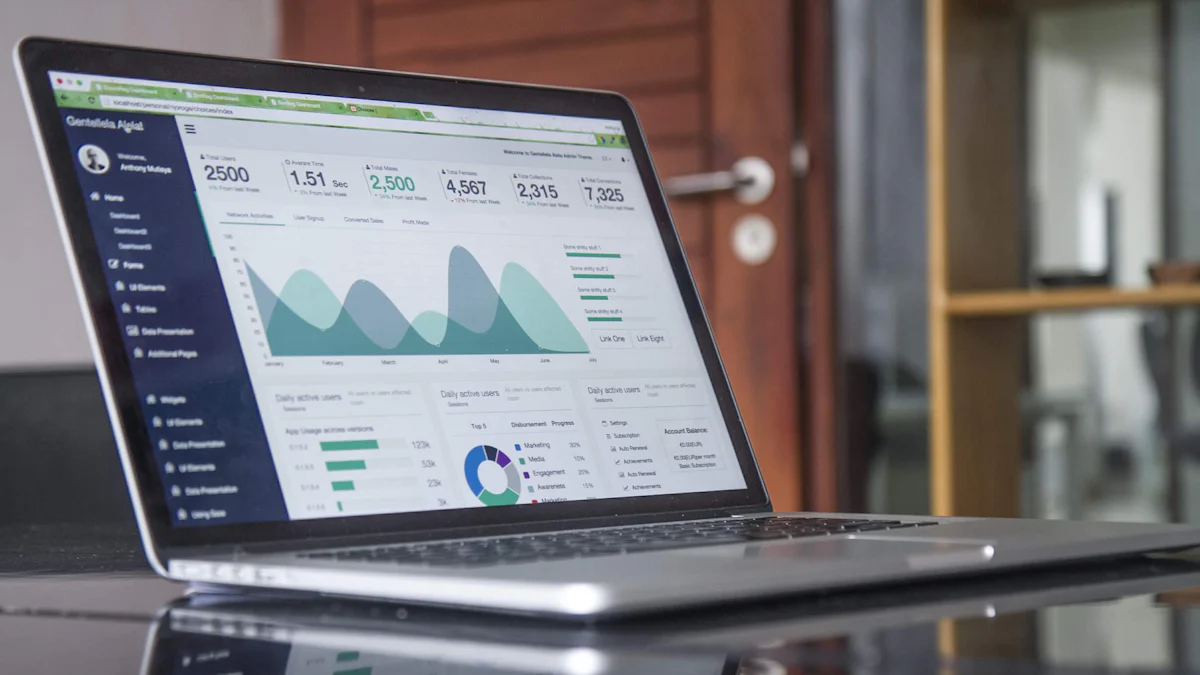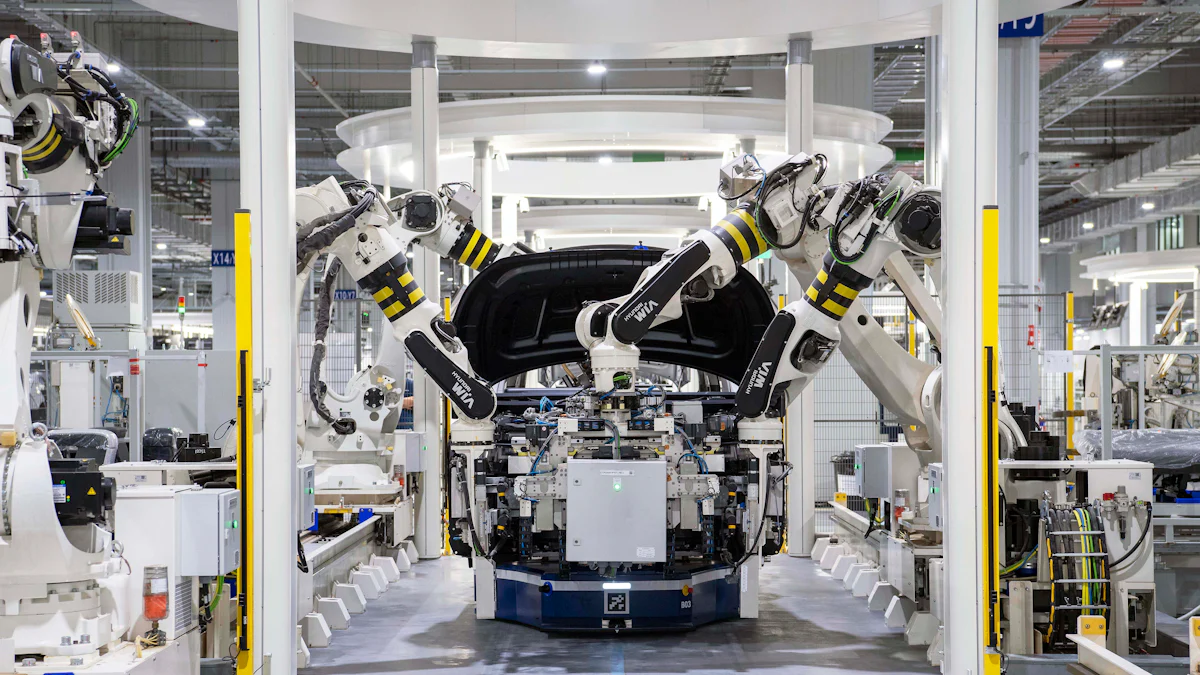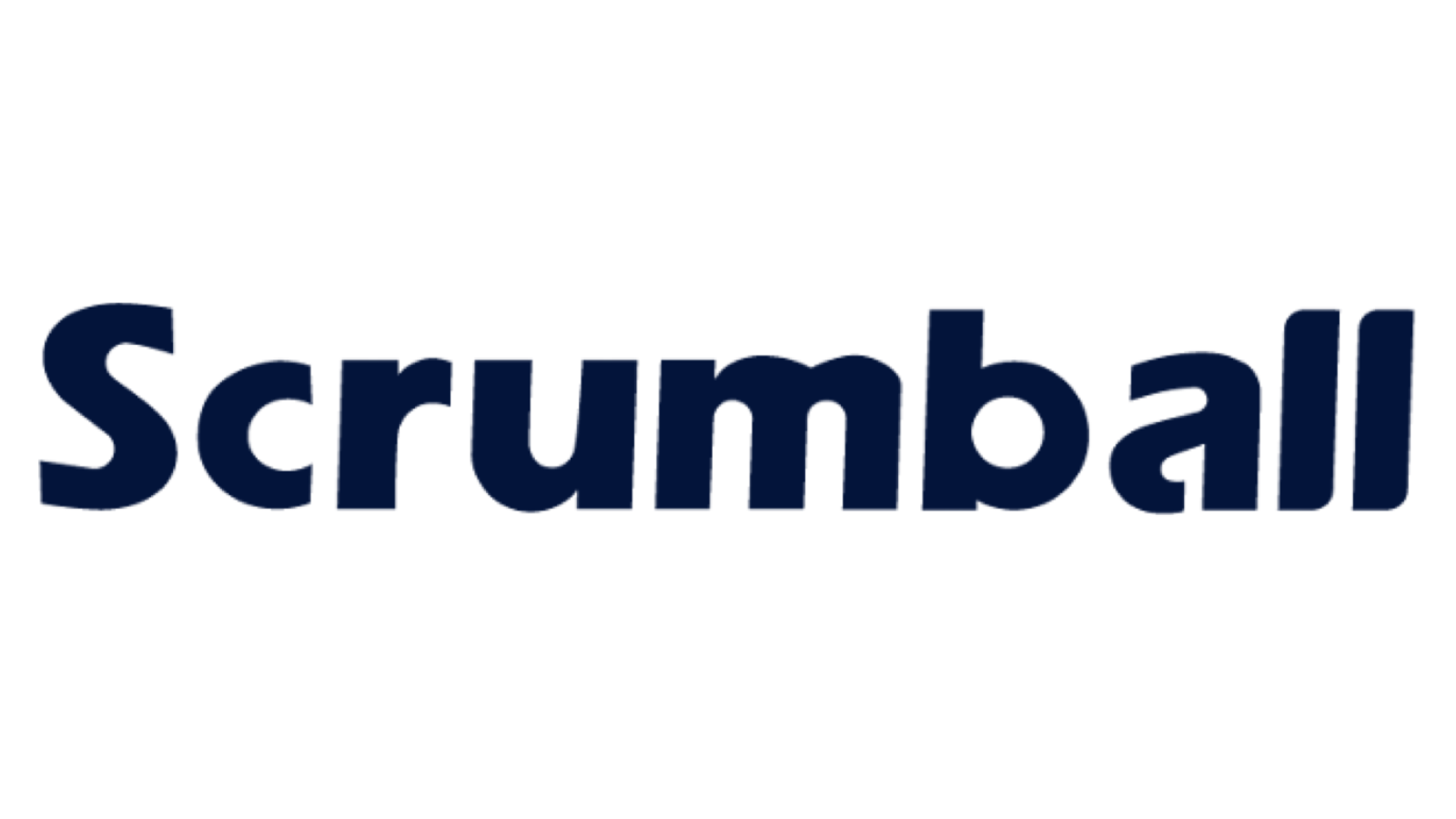Enterprise Marketing Automation Trends Shaping 2025

Marketing automation has become a cornerstone for enterprises aiming to thrive in a competitive landscape. By 2025, 91% of marketers will consider automation tools essential, with 72% of successful companies already leveraging them. These tools streamline processes, freeing up resources for strategic initiatives. They also enhance personalization, fostering stronger customer relationships through tailored communication. Enterprise marketing automation software empowers you to achieve higher ROI by automating repetitive tasks and delivering actionable insights. Staying ahead in this space ensures you remain agile, efficient, and deeply connected to your audience.
Understanding Marketing Automation in 2025
What Is Marketing Automation?
Marketing automation refers to the use of technology to streamline, automate, and measure marketing tasks and workflows. It allows you to focus on strategic activities while repetitive processes run in the background. By 2025, marketing automation will evolve significantly, driven by advancements in artificial intelligence and machine learning. These technologies will enable you to create automated customer profiles based on user preferences and behaviors. This means you can deliver highly personalized experiences without manual intervention.
Key characteristics of marketing automation in 2025 include:
- Stronger integration of artificial intelligence and machine learning.
- A focus on omnichannel marketing strategies.
- Hyper-personalized content delivery.
- Seamless integration with sales automation tools.
These features will help you better understand your audience and optimize your campaigns for maximum impact.
Why Marketing Automation Is Critical for Enterprises
In 2025, marketing automation will be indispensable for enterprises. A staggering 91% of marketers already consider it essential, and this trend will only grow. Automation frees up your time, allowing you to focus on creative and strategic aspects of your campaigns. It also enhances productivity by streamlining workflows and providing real-time analytics.
| Reason | Description |
|---|---|
| Hyper-personalization | Deliver personalized, timely, and relevant communications at scale. |
| Enhanced productivity | Free up sales and marketing teams to focus on strategic initiatives. |
| Real-time analytics | Instant reporting and insights into campaign effectiveness. |
By adopting marketing automation, you can improve customer engagement, boost efficiency, and achieve better ROI.
Key Drivers of Adoption in 2025
Several factors will drive the adoption of marketing automation in 2025:
- Increasing demand for personalized customer experiences.
- Advancements in artificial intelligence and big data analytics.
- Cost efficiency and improved ROI through automation.
- Rising adoption of cloud-based solutions.
- Growing reliance on digital marketing strategies.
The need for enhanced customer engagement and operational efficiency will push enterprises to embrace these technologies. Omnichannel marketing and hyper-personalization will also play a significant role in shaping how you connect with your audience. By leveraging these trends, you can stay ahead in a competitive market.
Trends to Watch in 2025

AI and Predictive Analytics
Smarter Campaigns with AI
AI in marketing will evolve from supporting tasks to driving entire strategies. You can use AI tools to target customers based on behavior, intent, and even emotional states. These tools will streamline processes like brainstorming and content production, saving you time and resources. Advanced AI systems, such as Salesforce Agentforce and Microsoft Copilot, will act as digital assistants capable of handling complex marketing tasks. Improved data integration will allow you to create hyper-personalized campaigns that resonate with individual customers.
AI-powered systems will also process vast amounts of data to forecast customer behavior. This capability will help you identify market opportunities and refine your strategies. By leveraging AI in marketing, you can create smarter campaigns that adapt to changing conditions in real time.
Predictive Analytics for Customer Insights
Predictive analytics will become a cornerstone of marketing automation in 2025. These tools will forecast customer needs by analyzing factors like weather patterns, local events, and purchasing trends. Real-time analytics will enable you to adjust your strategies dynamically, ensuring your campaigns remain relevant. Predictive analytics will also enhance customer engagement by delivering content tailored to individual preferences. This approach will improve conversion rates and make omnichannel marketing more effective.
Omnichannel Marketing Strategies
Seamless Customer Experiences
In 2025, customers will expect seamless experiences across all channels. You can achieve this by integrating your digital and physical touchpoints. For example, using AI and data analytics, you can anticipate customer needs and provide personalized product recommendations. Chatbots will offer instant support, ensuring customers feel valued at every stage of their journey. By focusing on personalization and transparency, you can build trust and foster long-term relationships.
Integrating Digital and Physical Channels
Omnichannel strategies will bridge the gap between digital and physical interactions. You can use technology to create a unified experience, whether customers shop online or in-store. For instance, offering real-time inventory updates or enabling online purchases with in-store pickups can enhance convenience. Emphasizing sustainability and transparency in your marketing efforts will also align with the growing consumer demand for ethical practices.
Hyper-Personalization
Data-Driven Personalization
Hyper-personalization will redefine customer experiences in 2025. By leveraging advanced data analytics and AI, you can tailor your services to individual preferences. For instance, financial institutions can offer personalized advice based on spending habits and goals. Research shows that 80% of customers prefer buying from companies that provide personalized experiences. This trend will help you foster loyalty and gain a competitive edge.
Real-Time Tailored Messaging
Real-time messaging will play a crucial role in hyper-personalization. You can use AI to analyze customer behavior and deliver messages that align with their immediate needs. This approach will ensure your communication feels relevant and timely, improving engagement and driving conversions. By adopting real-time tailored messaging, you can stay ahead in the competitive landscape of marketing automation.
Data Privacy and Compliance
Adapting to Privacy Regulations
In 2025, data privacy will remain a top priority for marketing automation. Regulations like GDPR in the EU and CCPA in the United States will set the standard for compliance. Adapting to these rules will not only protect your business from hefty fines but also build trust with your audience. You must integrate privacy measures into your marketing strategies to stay competitive.
- Marketing automation will increasingly depend on data science.
- The growing volume of shared data will lead to stricter regulatory requirements.
- Navigating these evolving regulations will be essential for success in 2025.
By prioritizing compliance, you can ensure your campaigns respect customer privacy while maintaining effectiveness.
Ethical Data Practices
Ethical data practices will define successful marketing automation in 2025. Customers will expect transparency about how their data is collected and used. You should focus on obtaining explicit consent and using data responsibly. Ethical practices will not only help you comply with regulations but also foster long-term customer loyalty. By demonstrating respect for privacy, you can differentiate your brand in a crowded market.
Generative AI in Content Creation
Automated Content at Scale
Generative AI will revolutionize content creation in 2025. These tools will allow you to produce high-quality content in minutes rather than hours or days. You can use AI to craft personalized messages for specific audience segments, enhancing engagement. By automating repetitive tasks, generative AI will free up your creative team to focus on strategy and storytelling. This approach will improve efficiency and ensure your content resonates with your audience.
Balancing Automation and Creativity
While generative AI offers speed and scalability, balancing automation with creativity will be crucial. You should use AI to handle routine tasks while leaving room for human input in areas like brand voice and storytelling. This balance will ensure your content feels authentic and aligns with your brand identity. By combining the strengths of AI and human creativity, you can create campaigns that stand out in 2025.
No-Code and Low-Code Platforms
Simplifying Marketing Automation
No-code and low-code platforms will simplify marketing automation in 2025. These tools will enable you to automate tasks and generate reports without requiring technical expertise. By reducing complexity, they will allow your team to focus on strategic goals. Companies using these platforms will also benefit from lower maintenance costs, which could decrease by up to 40%. This cost efficiency will make these platforms an essential part of your marketing toolkit.
Empowering Non-Technical Teams
No-code and low-code platforms will empower your non-technical teams to innovate. You can use these tools to customize workflows and adapt to market changes quickly. This flexibility will reduce your reliance on IT and improve productivity. By enabling your team to create solutions tailored to their needs, you can foster agility and stay ahead in the fast-paced world of marketing automation.
Zero-Party Data Utilization
Leveraging Direct Customer Input
Zero-party data will transform how you connect with your audience in 2025. Unlike third-party data, zero-party data comes directly from customers who willingly share their preferences, interests, and needs. This voluntary exchange fosters trust and transparency, which are essential for building strong relationships. By asking customers for their input through surveys, quizzes, or preference centers, you can gather valuable insights without relying on invasive tracking methods.
Brands are already using zero-party data to create hyper-personalized experiences. For example, you can design product recommendations or offers that align perfectly with individual preferences. This approach ensures your audience feels heard and valued. Additionally, zero-party data allows you to anticipate customer needs more accurately, helping you deliver personalized content that resonates.
Enhancing Personalization and Loyalty
Zero-party data will play a pivotal role in enhancing personalization and loyalty. By leveraging this data, you can craft customer-centric loyalty programs tailored to unique desires. For instance, you might offer rewards based on specific hobbies or shopping habits. This level of customization strengthens emotional connections with your brand, encouraging repeat business.
The transparency of zero-party data collection also builds trust. Customers appreciate knowing how their information is used, which makes them more likely to engage with your brand. When you use this data to deliver personalized content, you demonstrate that you value their input. Over time, this approach fosters loyalty and positions your brand as a trusted partner in their journey.
In 2025, zero-party data will redefine how you approach marketing. By focusing on direct customer input, you can create meaningful, personalized interactions that drive long-term loyalty.
Benefits of Enterprise Marketing Automation Software
Boosting Operational Efficiency
Enterprise marketing automation software significantly enhances operational efficiency by automating repetitive tasks. You can schedule emails, track leads, and segment audiences with minimal effort. This automation allows your team to focus on strategic activities that drive growth. Businesses using these tools report a 20% increase in productivity.
Automation also improves lead management. By prioritizing high-quality leads, you can enhance conversion rates and streamline your sales funnel. Real-time analytics provide actionable insights, enabling you to make data-driven decisions quickly. These tools also reduce costs over time, as the long-term savings from improved performance outweigh the initial investment.
For example, advanced analytics and reporting features allow you to monitor campaigns in real time. This capability ensures you can adjust strategies as needed, maximizing efficiency. By adopting enterprise marketing automation software, you can optimize workflows and achieve better results with fewer resources.
Enhancing Customer Engagement
Marketing automation transforms how you connect with your audience. Personalized interactions, powered by automation, create meaningful connections. For instance, companies that fully embrace these tools experience a 53% higher conversion rate. Personalized emails alone generate six times higher transaction rates.
You can use automation to deliver tailored messages at the right time. Features like abandoned cart reminders and follow-ups improve engagement and retention. One company saw a 20% increase in customer retention within three months of implementing these strategies.
Customers now expect personalized experiences. A Salesforce survey found that 70% of consumers feel more connected to brands that deliver them. By leveraging enterprise marketing automation software, you can meet these expectations and foster long-term loyalty.
Driving ROI and Revenue Growth
Enterprise marketing automation software drives ROI by simplifying routine tasks and enabling personalized campaigns. Customizing messages for specific audience segments boosts relevance and engagement. This approach not only improves customer engagement but also increases conversion rates.
Efficient lead management, through lead scoring and nurturing workflows, ensures you focus on high-value prospects. Integration across tools enhances collaboration, creating a seamless customer experience. Actionable insights from analytics refine strategies and help allocate resources effectively.
By adopting these tools, you can achieve measurable revenue growth. Businesses leveraging personalization at scale report revenue gains of 5% to 15%. Marketing automation ensures you maximize ROI while staying competitive in 2025.
Challenges in Adopting Marketing Trends
Over-Automation Risks
Over-automation can harm your marketing efforts. When you rely too heavily on automation, your campaigns may lose the human touch that customers value. Automated messages can feel impersonal, especially if they fail to address specific customer needs. This disconnect can lead to lower engagement and even damage your brand reputation.
You must also monitor the risk of errors in automated workflows. For example, sending duplicate emails or irrelevant offers can frustrate your audience. These mistakes often occur when automation tools lack proper oversight. Balancing automation with human input ensures your campaigns remain authentic and effective.
Data Quality and Integration Challenges
Data quality and integration present significant hurdles in marketing and sales automation. Poor data quality can derail your campaigns. Inconsistent, outdated, or incomplete data leads to inaccurate targeting and wasted resources. For instance, duplicate entries or outdated customer information can compromise your efforts.
Integrating automation tools with existing systems adds another layer of complexity. Many enterprises struggle to connect new platforms with legacy systems or data silos. This challenge often slows down the transformation process. A recent study found that 54% of businesses cite data quality and completeness as their largest marketing data management challenge. Addressing these issues is crucial for successful marketing trends adoption in 2025.
Budget Constraints and Resource Allocation
Budget constraints often limit your ability to adopt new marketing trends. Advanced tools for marketing and sales automation require significant investment. Smaller enterprises may find it difficult to allocate resources for these technologies.
You also need to consider the cost of training your team. Without proper training, your staff may struggle to use automation tools effectively. This gap can reduce the return on your investment. Careful planning and prioritization help you overcome these financial challenges while staying competitive in a rapidly evolving market.
Ethical and Sustainable Marketing Practices

Responsible Use of AI and Data
Using AI and data responsibly in marketing automation ensures ethical practices and builds trust with your audience. Transparency plays a key role. When you explain how AI systems work and how data is used, you create accountability and foster confidence. Giving consumers control over their data aligns with regulations like GDPR and CCPA. This approach not only ensures compliance but also strengthens customer relationships.
Privacy-enhancing technologies (PETs) offer another layer of protection. These tools safeguard consumer data while enabling effective marketing strategies. For example, PETs can anonymize data, ensuring privacy without sacrificing insights. Algorithmic fairness is equally important. By preventing biases in AI decision-making, you uphold ethical standards and promote inclusivity. These practices ensure your marketing automation strategies remain both effective and ethical.
Promoting Sustainability in Marketing
Sustainability in marketing focuses on promoting products and services in an environmentally and socially responsible way. Authenticity and transparency are essential. When you align your marketing strategies with sustainability goals, you resonate with eco-conscious consumers. Educating your audience about your sustainability mission enhances engagement and loyalty. For instance, sharing stories about your efforts to reduce waste or use renewable energy can inspire trust.
Sustainable marketing requires a long-term commitment. Viewing it as more than a short-term sales strategy ensures consistency. Integrating sustainable practices across your organization aligns all activities with your goals. Consistent messaging is crucial. It communicates your sustainability commitments to customers and keeps employees motivated. By adopting these principles, you position your brand as a leader in ethical and sustainable marketing practices.
In 2025, ethical and sustainable marketing will be more important than ever. By prioritizing responsible AI use and sustainability, you can build trust, foster loyalty, and stay ahead in a competitive market.
How to Leverage the Future of Marketing Automation
Conducting a Marketing Automation Audit
A marketing automation audit helps you identify gaps and optimize your strategies. Start by assessing your internal resources. Check if your team has the skills and knowledge to manage automation tools effectively. Evaluate whether your personnel can handle tasks efficiently or if additional training is needed. Compare your current strategies with those of top competitors to uncover areas for improvement. Prioritize changes that offer the highest ROI and align with your business goals.
Tip: Regular audits ensure your automation tools stay aligned with the evolving future of marketing automation. This proactive approach keeps your campaigns efficient and impactful.
Selecting the Right Enterprise Marketing Automation Software
Choosing the right software is critical for success. Look for tools that support multi-region marketing and offer reliable customer support. Ensure the software includes robust data analytics and reporting features. User-friendliness and integration capabilities are also essential.
Follow these steps to make an informed decision:
- Identify the most important attributes, such as ease of implementation, scalability, and AI assistance.
- Assess affordability based on your budget.
- Test customization options to see if the software meets your needs.
- Confirm the availability of customer support and after-sales assistance.
- Verify integration capabilities with your existing tech stack.
Selecting the right software ensures you can scale your efforts and improve the customer experience without unnecessary hurdles.
Training Teams for Success
Proper training prepares your team to maximize the benefits of automation tools. Offer hands-on workshops and detailed tutorials to help them understand all functionalities. Establish a helpdesk or regular Q&A sessions to address ongoing questions. Tailor training sessions to the specific needs of different teams, ensuring everyone knows how to apply the tools effectively.
Introduce the tools gradually to avoid overwhelming your team. Highlight the benefits of automation, such as improved efficiency and enhanced customer experience, to motivate adoption. Leadership endorsements can also build trust and encourage your team to embrace the changes.
Note: A well-trained team ensures you can fully leverage the future of marketing automation while maintaining a competitive edge.
Continuous Testing and Optimization
Continuous testing and optimization ensure your marketing automation efforts remain effective and relevant. By regularly evaluating your campaigns, you can identify areas for improvement and refine your approach to achieve better results.
A/B testing is one of the most effective methods for optimization. It allows you to compare two versions of a marketing asset, such as an email or landing page, to determine which performs better. This iterative process helps you make data-driven decisions and improve campaign performance over time. Multivariate testing takes this a step further by testing multiple variables simultaneously. This method uncovers how different elements interact, enabling you to fine-tune your campaigns for maximum impact.
Audience segmentation plays a crucial role in delivering tailored content. By automatically grouping your audience based on criteria like demographics or behavior, you can create personalized experiences that resonate with each segment. Behavior-based triggers further enhance this process. These triggers respond to specific customer actions, such as clicking a link or abandoning a cart, ensuring your messages are timely and relevant.
Automated campaigns designed for different stages of the customer journey also contribute to optimization. For example, you can create workflows that nurture leads, onboard new customers, or re-engage inactive users. Regularly testing elements like subject lines, call-to-action buttons, and visuals ensures your campaigns remain fresh and engaging.
Data-driven insights are the foundation of continuous testing. By analyzing performance metrics, you can identify trends and adjust your strategy to align with customer preferences. This proactive approach keeps your marketing efforts agile and effective in a rapidly changing landscape.
Embracing marketing automation trends like AI, omnichannel strategies, and hyper-personalization will position you for success in 2025. These innovations enable you to create adaptive campaigns, integrate customer experiences across channels, and deliver personalized customer journeys that resonate. Ethical and sustainable practices, such as reducing carbon footprints and supporting fair trade, foster trust and long-term loyalty.
To stay competitive, prioritize tools like CRM-integrated platforms, AI-powered marketing solutions, and data analytics. These strategies ensure agility, efficiency, and relevance in a rapidly evolving market. Act now to future-proof your marketing efforts and build lasting customer relationships.
FAQ
What is the role of marketing automation in digital marketing trends?
Marketing automation plays a key role in digital marketing trends by streamlining tasks and improving efficiency. It helps you deliver targeted campaigns, analyze performance, and adapt strategies quickly. This ensures you stay competitive in a fast-changing digital landscape.
How does marketing automation enhance personalized communication?
Marketing automation enables you to tailor messages based on customer behavior and preferences. It uses data to create personalized communication at scale, ensuring your audience receives relevant and timely content. This approach improves engagement and builds stronger relationships.
Can small businesses benefit from marketing automation?
Yes, small businesses can benefit greatly. Automation tools simplify workflows, save time, and improve customer targeting. They also make personalized communication more accessible, helping you compete with larger enterprises while staying within budget.
How do you ensure ethical use of customer data in marketing automation?
You ensure ethical data use by being transparent about data collection and usage. Always obtain consent and follow privacy regulations. Use data responsibly to build trust and maintain compliance with laws like GDPR and CCPA.
What are the biggest challenges in adopting marketing automation?
The biggest challenges include high initial costs, data integration issues, and the risk of over-automation. You must also train your team to use tools effectively. Addressing these challenges ensures successful implementation and long-term benefits.
See Also
Key Influencer Marketing Trends You Should Follow in 2024
15 Essential Influencer Marketing Platforms for 2024 Success
Best Influencer Marketing Platforms to Boost E-commerce Growth
Effective TikTok Influencer Marketing Techniques for 2024
Practical Influencer Marketing Data for Better Decision Making
